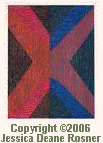Post appears BELOW Table of Contents.
This blog focuses on similarities between others' four-folds, tetrads, tetrachotomies, and mine, and includes links to online information on others’ fours in their own terms. It results from overgrowth of an old post at The Tetrast "What of these other fours?".|
Table of Contents Fours that I've adopted or adapted:
Fours with a striking likeness to mine: Fours involving some likeness to mine: |
More-or-less different fours:
|
Unless otherwise stated within the post, first posted on Friday, December 5, 2008. Post times here are just a device to control the order of appearance. Most of the posts are based on entries in an older post "What of These Other Fours?" at The Tetrast.
Alain Badiou's Four Discourses
Alain Badiou's Four Discourses or “truth procedures” — Art, Love, Politics, and Science — (Skip table ►)
“...the four generic 'conditions' of philosophy itself.... These are the only four fields in which a pure subjective commitment is possible, i.e. one indifferent to procedures of interpretation, representation or verification.” (See Badiou’s EGS faculty biography.) The Wikipedia article adds the caveat that “Badiou consistently maintains throughout his work that philosophy must avoid the temptation to attach its own truth to that of any of the discourses, a process he terms a philosophical ‘disaster’.” I see no obvious correlation here with my fourfolds. Three or possibly all four of Badiou’s Four Discourses appear in my 4x4 classification of aspects of humanity which lend themselves to social compartmentalization. There’s hardly any pattern visible in the resultant distribution in the table. So, right off the bat, I see hardly any correlation. I haven’t studied in any detail Badiou’s justifications for singling exactly those four things out, but the justifications sound unpromising. If Badiou makes a four-way distinction among object (subject matter), representation, interpretation, and verification, then, at least there, I’ll agree with him.
Alain Badiou's Four Discourses or “truth procedures” — Art, Love, Politics, and Science — (Skip table ►)
SECOND level About(the ROWS), INTER-BEHAVIORS ___ ___ ___ ___ FIRST level (the COLUMNS), SECTORS | Beginnings, leadings, decision-makings | Middles, means, abilities, resources, dealings | Ends, endings, culminations, completions, satisfactions | Checks, entelechies, establishings, knowledge | ||
|---|---|---|---|---|---|---|
Subhead (sector) Appropriation, adoption, control: | Subhead (sector) Processing, production, adaptation: | Subhead (sector) Consumption, expression, conversion: | Subhead (sector) Digestion, rumination, assimilation: | |||
Beginnings, leadings, decision- makings | Vyings, arenas: | Affairs of power, freedom. (Badiou's "Politics.") | Business, trade, finance, wealth. | Show, games, sports, fashion, “wattage.” | Case-building, validation, standing, honor. | |
Middles, means, abilities, resources, dealings | Practices, cooperations, tolerances, occupational spheres & concourses: | Administration, management, compliance, adjustment. | Labor, work, collaboration. | Leisure, hobbies, repasts, celebrations, observances, recreations, pastimes. | Study, investigation, review, discussion, reporting. | |
Ends, endings, culminations, completions, satisfactions | Valuings, distinctive unitings, communities: | Ruling / governing valuings. | Care-how. | Tastes & valuings about feelings. (Badiou's "Love"?) | Valuings about cognition & legitimacy. | |
Checks, entelechies, establishings, knowledge | Checks & balances, supports, disciplines: | Ruling / governing arts. | Know-how, productive arts/sciences. | Affective arts. (Badiou's "Art.") | Maths & sciences. (Badiou's "Science.") | |
Hello, I'm very happy that I came to your page, by the way, via an article from Rudolf Kaehr about Diamond Calculus, you might check this also out. He is working in the tradition of the German philosophy Gotthard Günther. He dualizes Spencer-Brown indicational calculus to differential calculus and develops this into a tetrad, this, other, this and other, none.
But the important one (directly based on Aristotle's four causes) you might have missed is here:
John J. Kineman, Relational Science: A Synthesis
http://relationalscience.org/wp-content/uploads/2011/06/R-theory-Synthesis.pdf
Related and discussed in this is Louis: More than Life Itself.
Ah, and also Arthur Young: 'The Geometry of Meaning' comes to mind. He develops first the four, then the three, then the two and puts it all together with physics (length, time, mass) in a twelve around the circle.
All the best, keep the good work!
Marcus
Thanks for the encouragement!
Years ago I saw some of Kaehr's Diamond theory, but couldn't understand it at all. It's way over my head.
I'd seen some Spencer Brown but I'm afraid he's over my head too - I lack the background to understand him.
In the past, Young's talk of derivatives didn't make sense to me, but I've just looked again and found his actual formulas and found that he was discussing a pendulum, so now it makes a little more sense to me, but his connections of those things with broader ideas still seem arbitrary to me.
Kineman is new to me, I'll be looking into him, thank you!
I hadn't seen this page in Internet Explorer for years, I see that now my table doesn't look right. Still works in Firefox, though.
Thanks again for your comment!
Post a Comment
Years ago I saw some of Kaehr's Diamond theory, but couldn't understand it at all. It's way over my head.
I'd seen some Spencer Brown but I'm afraid he's over my head too - I lack the background to understand him.
In the past, Young's talk of derivatives didn't make sense to me, but I've just looked again and found his actual formulas and found that he was discussing a pendulum, so now it makes a little more sense to me, but his connections of those things with broader ideas still seem arbitrary to me.
Kineman is new to me, I'll be looking into him, thank you!
I hadn't seen this page in Internet Explorer for years, I see that now my table doesn't look right. Still works in Firefox, though.
Thanks again for your comment!
. . . . |



